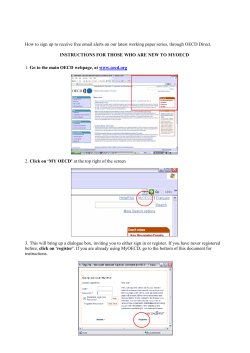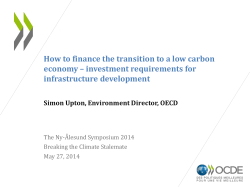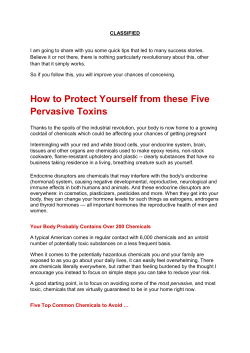
EU Regulation 1107/2009, recent developments and how to work with it
EU Regulation 1107/2009, recent developments and how to work with it David Kirkpatrick Regulation 1107/2009 – key issues • • • • • Where are we now? Regulatory review timelines Data requirements Risk assessment guidance Hazard criteria – Endocrine disruption – PBT • Substitution candidates and comparative assessment • Classification, labelling and packaging (CLP) Where are we now? • Regulation 1107/2009 has been in operation for one year • 67 new active substances that were delayed in EFSA by the 91/414 review programme, are still in the system (Regulation 188/2011) • First new active substances submitted under 1107/2009 are expected to reach EFSA in 2013 • Resources at EFSA are an issue • New data requirements close to finalisation • New guidance being developed in many areas of risk assessment Timeline for new substance review under 1107/2009 Applicant submits dossier to RMS RMS does completeness check: 45 days RMS requests additional information/studies: max 3 months RMS prepares DAR and submits to EFSA and Commission: 12 months RMS requests additional information/studies: max 6 months EFSA sends DAR to other MS: 30 days Other MS can comment: 60 days EFSA requires expert meeting: 30 days EFSA adopts conclusion: 120 days EFSA requires more information: Applicant 90 days, RMS 60 days Commission presents report and draft regulation to SCFCAH: 6 months The review process Should be faster than under 91/414 but… …to minimise delays: – Try to make the dossier as complete as possible – Reduce scope for authorities to request additional information – Try to reduce potential need for new studies • There will still be questions and requests for information – These should be answered as quickly as possible • Remember, there is no provisional approval process Data requirements – current status • Most recent drafts dated March 2012 • Active substance – SANCO/11802/2010 Rev. 3 (POOL/E3/2010/11802/11802R3-EN.doc) • Plant Protection Product – SANCO/11803/2010 Rev.3 (POOL/E3/2010/11803/11803R3-EN.doc) • Final versions expected Q3 2012 • Two year window before obligatory • But best to pay attention now – will apply to AIR 3 Main new data requirements: human risk assessment Discipline Toxicology Residues New requirement Status Purpose Comparative in vitro metabolism Mandatory Toxicology species relevance to man Toxicokinetic data in short and long-term and reproductive studies Mandatory (but not all studies) Dose selection Interpretation of toxicology studies Phototoxicity, Photomutagenicity Conditional Developmental neurotoxicity – where indicated by other studies or MoA Conditional Human risk assessment Residue trials in crops – possible reduction in requirements Mandatory Fish metabolism, feeding Conditional Rotational crop metabolism and residues – new approach Conditional Residues in honey Conditional Dietary risk assessment Main new data requirements: environmental risk assessment Discipline Environmental fate Ecotoxicology New requirement Status Purpose Field soil dissipation – additional DT90 triggers Conditional Capture biphasic cases Aged sorption Optional Higher tier model inputs Indirect photolysis in water Conditional Aerobic mineralisation in surface water, OECD 309 Mandatory in most cases Environmental risk assessment Amphibian metamorphosis, choice of fish studies – 21-day, short term repro, sexual development, life cycle Conditional Endocrine disruption tests Fish bioconcentration: New trigger hydrolysis DT90 >24 hr. Log POW >3 still applies Capture long term exposure Studies with bees – new guidance being developed Mandatory Protection of pollinators Environmental risk assessment guidance • Aquatic: – Existing document (SANCO 3268/2001) to be split into four separate guidance documents – EFSA has requested a mandate extension. Public consultation of first document expected Autumn 2012 • Terrestrial – Existing document (SANCO 10329/2002) to be split into six separate guidance documents – Opinion on bees published May 2012 – EFSA’s deadlines for the others range from March 2014 to June 2017 Risk assessment for bees: key questions • Impact of pesticides on colony development and survival • Effects of long-term exposure to low concentrations of pesticides • Cumulative effects of combinations of pesticides – Honey bees have the lowest number of detoxification enzymes in the insect kingdom • Measurement of exposure in field studies • Ability of current field tests to detect small increases in daily mortality or sub-lethal effects EFSA Journal 2012;10(5):2668 http://www.efsa.europa.eu/en/efsajournal/pub/2668.htm Risk assessment for bees: EFSA proposals • Separate assessment schemes for honey bees and for bumble bees/solitary bees • Initial testing to include an exposure period of seven to ten days for both adult bees and larvae. • Investigation of exposure via both nectar and pollen • Improvements to design of existing semi-field and field tests • Statistical analysis of test results • Of course this is all open to public comment before it becomes “Guidance” • But there will be new data requirements Other areas where guidance is being revised or under development • • • • Persistence in soil Probabilistic dietary risk assessment Cumulative dietary risk assessment Operator, worker, bystander, resident risk assessment • Protected crops • Concept of Threshold of Toxicological Concern Hazard criteria • For approval – Carcinogenic, mutagenic, toxic for reproduction (CMR), category 1A or 1B – Endocrine disrupter – Environmental properties: POP, PBT, vPvB • For substitution (additional to approval criteria) – ADI, ARfD or AOEL much lower than other competitor active substances – 2 of PBT criteria – Neurotoxic or immunotoxic effects of concern – Active substance contains inactive isomers Endocrine disruption – provisions of 1107/2009 • By 14 December 2013, Commission must present a draft proposal of specific scientific criteria for the determination of endocrine disrupting properties • Pending the adoption of these criteria: • Substances classified as C2 and R2, shall be considered to have endocrine disrupting properties • Substances classified as R2 and which have toxic effects on the endocrine organs, may be considered to have endocrine disrupting properties (Annex II, 3.6.5 and 3.8.2) The OECD framework for Testing and Assessment of Endocrine Disrupters Level Test types 1 Sorting & prioritization based upon existing information 2 In vitro assays providing mechanistic data 3 In vivo assays providing data about single endocrine mechanisms and effects 4 In vivo assays providing data about multiple endocrine mechanisms and effects 5 In vivo assays providing adverse effects data from endocrine & other mechanisms http://www.oecd.org/document/58/0,3343,en_2649_34377_2348794_1_1_1_1,00.html Recent progress • February 2012: Commission report – “State of the Art of the Assessment of Endocrine Disruptors” – Issues: • Appropriate tests and endpoints for the identification of ED properties need to be implemented • Criteria for the translation of test outcomes into regulatory decisions need to be developed Some recommendations on testing: human health • Testing in whole organisms is required to identify an endocrine disrupter • Tests from OECD Level 5 should be mandatory • ED endpoints should be added to reproductive studies (2-gen or extended 1-gen, OECD 416 or 443) • Developmental neurotoxicity and immunotoxicity are of particular relevance • OECD Level 2 in vitro tests should be included in requirements • Uterotrophic and Hershberger tests are of questionable value Some recommendations on testing: ecotoxicology • Current testing requirements limited – could only detect ED effects on birds and possibly fish • Most OECD Level 4 and 5 tests still under development • For now, assessment has to rely on currently available OECD Level 3 tests • To demonstrate wildlife ED effects, inclusion of all validated test guidelines for non-mammalian species at Levels 3, 4 and 5 will have to be considered Decision criteria considered • Adversity – are there effects in intact organisms? • Mode of action - has to be ED • Potency - linked to STOT RE classification - very controversial – For, Germany, UK; against, Denmark, France • Lead toxicity - ED effects at lower doses than other effects • Specificity - direct MoA or environmental species specificity • Severity - should effect be classed as C, M or R? • Irreversibility • Relevance - human or environmental health Some overall recommendations • Develop further guidance documents for the interpretation of test data • Consider the creation of a separate regulatory class “Endocrine Disrupter” (ED) • Develop weight-of-evidence procedures and use them to consider all proposed criteria in parallel • Abandon “potency” as a rigid cut-off criterion Substitution candidates and comparative assessments Objectives: • To reduce risks from the use of plant protection products by gradually replacing those containing substitution candidates by methods or products of lower risk • To benefit human health and the environment, whilst minimising the economic and practical disadvantages for agriculture Regulatory framework • Active substances – Identification as candidates for substitution is a community level process – EFSA, MS, COM – Approval periods will be limited – Selection based on hazard criteria – List of candidates to be published by Dec 2013 • Plant protection products (PPP) – Comparative assessment and substitution is a Member State process Article 50(1) – mandatory comparative assessment of a PPP containing a candidate for substitution • MS shall not authorise or shall restrict the use if – A product or non-chemical method exists which is significantly safer for human or animal health or the environment – The substitution does not present significant economic or practical disadvantages – The chemical diversity of active substances or methods and practices are adequate to minimise the occurrence of resistance, and – The consequences on minor uses are taken into account Comparative assessment: criteria to be considered Criterion 1a Is there an alternative product or non-chemical method available? Criterion 1b Has sufficient experience of the alternative been gained? Criterion 2 Is there a negative effect of efficacy? Criterion 3 Is chemical diversity protected? Criterion 4 Are minor uses protected? Criterion 5 Are there significant practical or economic disadvantages? Criterion 6 Are the risks to man and the environment significantly lowered? Over time it is important to consider experience gained on the consequences of substitution Annex IV of Regulation 1107/2009 states that all criteria should be met before substitution applies Comparative assessment responsibility for guidance • Efficacy • Risk of developing resistance • Practical/economical disadvantages, and effects on minor uses EPPO • Risks for health and the environment • Final decision (risk/benefit) Sweden proposal Sweden believes that products fulfilling all provisions for substitution will probably be few Comparative assessment: ECPA Position “Comparative assessment must be applied using pragmatism, rigor and robust scientific principles to prevent unwarranted substitutions and further deterioration of the competitiveness of European agriculture.” • Notifier should be asked to comment during the assessment • Notifier should be informed prior to any decision being made • It is not possible for human health to take precedence over environmental health and vice versa Persistence, Bioaccumulation, Toxicity • Persistence criterion is most easily triggered – E.g. DT50 soil > 60 days applies to many active substances – Introduction of OECD 309 may bring in more substances • Bioaccumulation is rarely triggered – Few substances have BCF > 2000 • Toxicity – range of test organisms is wide, so this can be an issue • For approval to be refused, all 3 criteria have to be met so rarely a problem • For substitution candidacy only 2 have to be met – trade-off between persistence and toxicity Classification • In addition to 1107/2009, plant protection products (PPP) are subject to the Classification, Labelling and Packaging (CLP) Regulation 1272/2008 • Manufacturers, importers and downstream users are responsible for proposing a classification before a substance is placed on the market • For PPPs the situation is complicated because the RMS or EFSA may propose a classification that the notifier does not agree with • EFSA , ECHA and MSCAs are developing a plan on how to work together ECHA = European Chemicals Agency, MSCA = Member State Competent Authority Conclusions • Regulation 1107/2009 has introduced some major changes to the way PPPs are approved in Europe • Time to registration should be faster than under 91/414 but “Provisional Approval” no longer exists • Industry is concerned about “substitution” – It remains to be seen how this will work • Immediate changes to data requirements are not major but eventually there will be significant additions relating to endocrine disruption and bees • Development of risk assessment guidance will continue for many years to come • Europe is a large market and it is still worth going for registration
© Copyright 2025



















